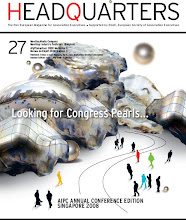 How often I've heard that the magazine era is over. The future lies in the internet, the digital newsletter, people say. Let's be clear, I'm talking about meetings industry magazines that are often looked upon as boring, poor in journalism and above all reservoirs of advertisements. In short: not good. So, not many people in our industry really read those magazines.
How often I've heard that the magazine era is over. The future lies in the internet, the digital newsletter, people say. Let's be clear, I'm talking about meetings industry magazines that are often looked upon as boring, poor in journalism and above all reservoirs of advertisements. In short: not good. So, not many people in our industry really read those magazines.I was very pleased to read an interview with creative prodigy, style guru and the person who thought up the cult magazine 'Wallpaper': Tyler Brûlé. Earlier this year, he launched Monocle, the most debated magazine of the moment. To magazine fetishists it's a collector's item and I'm part of that group. Brûlé's team has launched a magazine in an age where everybody is talking about the demise of the print media. Today Monocle is the magazine everyone's talking about, designed for educated people who especially don't have time to read, except in airports, taxis and hotel rooms. Aren't those the same readers of meetings industry specialist journals? Monocle brings very good journalism and the paper is good quality. It's designer, colourful and it supplies stories for which people do want to make time. Touching something that feels good is unbeatable, says Tyler.
In the interview he admits that print media can never compete with the other media when it comes to 'breaking news', but there is no other medium that can rival the feeling of sitting down somewhere and reading an analysis. And that's exactly what I want to achieve with the
 upcoming EIBTM issue of HeadQuarters Magazine. Have a seat and read the pages 'Statistics make the Meetings Industry'. Lose yourself in the numbers and comments of UIA and ICCA for a minute. And maybe you'll read the IFLA portrait afterwards? And we are especially proud that we were also able to publish the results of ‘The Monocle Quality of Life Index’ in this issue. Because there's more to the Meetings Industry than just numbers, it has a lot to do with ‘branding’ as well.
upcoming EIBTM issue of HeadQuarters Magazine. Have a seat and read the pages 'Statistics make the Meetings Industry'. Lose yourself in the numbers and comments of UIA and ICCA for a minute. And maybe you'll read the IFLA portrait afterwards? And we are especially proud that we were also able to publish the results of ‘The Monocle Quality of Life Index’ in this issue. Because there's more to the Meetings Industry than just numbers, it has a lot to do with ‘branding’ as well.Read all about meeting statistics and subscribe to HEADQUARTERS magazine.


 That's not how I remember the Marriott Hotels. He was wearing a special black and white jacket with black stylized patterns in the sides. His name tag gave away that he probably spoke Dutch. And indeed, Rik van Baar is a trainee from
That's not how I remember the Marriott Hotels. He was wearing a special black and white jacket with black stylized patterns in the sides. His name tag gave away that he probably spoke Dutch. And indeed, Rik van Baar is a trainee from 
 During the quiet month of August I've done some cycling in Paris myself: over 70 km. I've pedalled down the Champs-Elysées and I couldn't live without it now. There were two types of drivers I feared: taxi drivers and bus drivers! But I've been able to experience that cyclists have a calming effect on traffic and make a valuable contribution to the battle against pollution. Hats off to the Paris mayor Bertrand Delanoë who aims to have 1451 stations in Paris by the end of the year - that's about one every 300 meters - with a total of 20,600 bikes. The bicycle has made its appearance in London as well but
During the quiet month of August I've done some cycling in Paris myself: over 70 km. I've pedalled down the Champs-Elysées and I couldn't live without it now. There were two types of drivers I feared: taxi drivers and bus drivers! But I've been able to experience that cyclists have a calming effect on traffic and make a valuable contribution to the battle against pollution. Hats off to the Paris mayor Bertrand Delanoë who aims to have 1451 stations in Paris by the end of the year - that's about one every 300 meters - with a total of 20,600 bikes. The bicycle has made its appearance in London as well but 
















